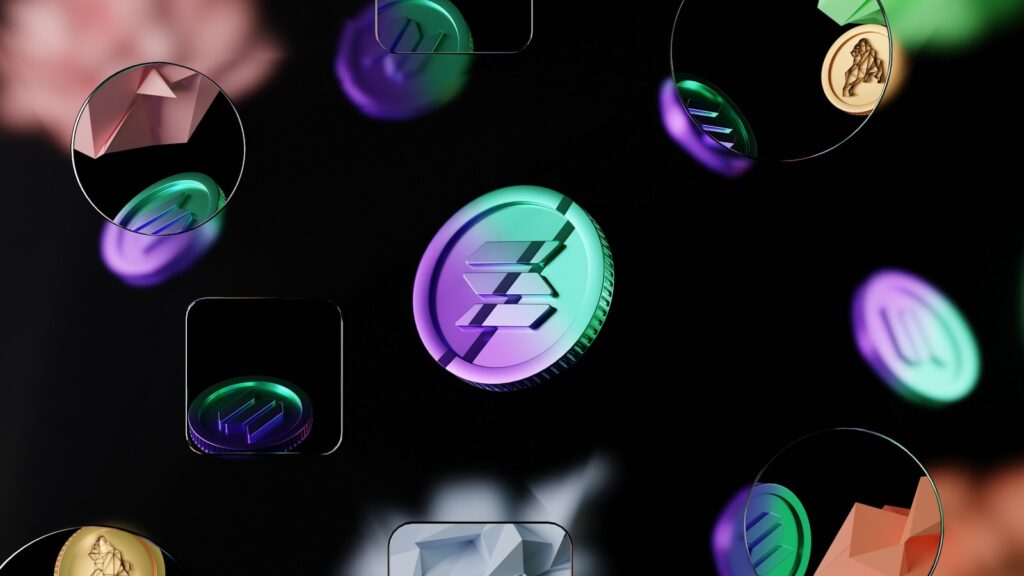Main Points:
- Market Performance Decline:
SOL has fallen below $200, marking a 34% drop from its January 19 peak of $295. - On-Chain Activity Diminishes:
A 28% drop in on-chain transaction volume over the past 7 days signals a slowdown, with notable declines in decentralized exchange (DEX) trading activities. - Meme Coin Market Slump:
Meme coins such as Dogwifhat (WIF), Goatseus Maximus (GOAT), Moodeng (MOODENG), Pnut the Squarl (PNUT), and Just a Chill Guy (CHILLGUY) have experienced significant decreases, reflecting a cooling of the recent meme coin frenzy. - Investor Sentiment and Derivatives:
Negative funding rates in SOL perpetual futures indicate a cautious investor outlook and reduced leveraged buying pressure. - Stable TVL and Growth Potential:
Despite current challenges, Solana’s Total Value Locked (TVL) remains stable at around 46.5 million SOL, and with prospects like a potential SEC-approved ETF, the network shows promise for attracting future institutional investment.
In the ever-evolving crypto landscape—where innovation and volatility often go hand in hand—Solana (SOL) is currently navigating a period of stagnation despite its robust technological foundation and thriving ecosystem. Recent market conditions have pushed SOL’s trading price below $200, a significant drop from its January 19 high of $295, while key on-chain metrics show declining activity. Investors, blockchain developers, and those scouting for new crypto assets or revenue streams are taking note. This article examines the various factors influencing Solana’s current performance, explores the implications of reduced network activity and the slump in meme coin trading, and discusses the network’s potential for a bullish turnaround driven by stable fundamentals and emerging institutional interest.
Market Performance Decline: Observations and Analysis
Solana’s native token, SOL, has experienced a notable decline recently. Once peaking at $295 on January 19, the token is now trading below the $200 mark—a 34% drop that has drawn considerable attention in the crypto community. Analysts point to multiple contributing factors behind this downturn, including overall market volatility, a decline in speculative trading, and a significant reduction in network activity.
The bearish sentiment among traders is evident in various derivative indicators. With investors becoming increasingly cautious, there has been a reduction in leveraged long positions on SOL, which has put further downward pressure on its price. The drop in SOL’s trading volume on decentralized exchanges (DEXs) has also led to a decrease in network-generated fees. This, in turn, impacts staking rewards, creating a negative feedback loop where lower incentives discourage further investment. Although Bitcoin has seen a modest 2% increase in the same period, the performance disparity between Bitcoin and altcoins like SOL underscores a shift in market sentiment that favors stability over speculative risk.
On-Chain Activity Diminishes: Impact on DEXs and Network Dynamics
Recent data from DefiLlama reveals that over the seven days ending February 10, Solana’s on-chain transaction volume fell by 28%. This decline in transaction volume is a key indicator of reduced network activity and user engagement. On-chain metrics are vital in understanding how active a blockchain is, and such a decrease suggests that the once-vibrant ecosystem may be experiencing a period of dormancy.
The reduction in activity is not confined solely to general network transactions. Major decentralized exchanges operating on Solana—such as Orca, Phoenix, and Raydium—have reported significant drops in their trading volumes, with Orca and Phoenix experiencing a 47% decrease and Raydium a 27% fall. This slowdown in DEX activity is particularly important because it reflects not only reduced trading but also lower fee generation, which can impact the incentives for staking and network participation.
It is also worth noting that this trend is not unique to Solana. Competing blockchains like BNB Chain, Ethereum, Sui, and Polygon have similarly reported decreased on-chain activity, suggesting that current market conditions are influencing the broader ecosystem rather than indicating a problem inherent to Solana alone.

Meme Coin Market Slump: What It Means for Solana’s Ecosystem
A significant factor contributing to the downturn in network activity on Solana has been the cooling off of the meme coin market. At the height of the recent meme coin boom, Solana experienced a surge in on-chain transactions and trading activity largely driven by speculative trading in meme tokens. However, in recent weeks, this fervor has diminished considerably.
For instance, popular meme coins on the network have seen dramatic declines. Dogwifhat (WIF) has dropped by 60% over the last 30 days, while other tokens like Goatseus Maximus (GOAT), Moodeng (MOODENG), Pnut the Squarl (PNUT), and Just a Chill Guy (CHILLGUY) have fallen by 67%, 69%, 72%, and 75% respectively. This rapid depreciation in meme coin values has not only affected the trading volumes but has also led to a broader cooling of market sentiment within the ecosystem.
The decline in meme coin trading is emblematic of a market recalibration, as investors increasingly shift focus away from highly speculative assets toward projects with more robust use cases and sustainable growth trajectories. While the meme coin phenomenon once drove rapid network activity, its current downturn highlights the volatility and risks associated with such investments. This market correction may ultimately benefit the ecosystem by redirecting attention to long-term projects and innovations that offer more practical applications and stable returns.
Investor Sentiment and Derivatives: A Cautionary Tale
Investor sentiment toward SOL has grown increasingly cautious, as reflected in the negative funding rates observed in SOL perpetual futures contracts. Since February 2, the funding rate for these contracts has remained predominantly negative, signaling that the market’s long positions are being pressured by a lack of bullish sentiment. In futures trading, a negative funding rate generally means that those holding long positions are paying fees to short sellers—a sign that market participants are hesitant to take on additional risk.
The implications of these negative funding rates extend beyond mere trading mechanics. They are a reflection of the broader market mood, which has become more risk-averse amid declining network activity and reduced fee generation. Rather than engaging in aggressive speculative buying, investors seem to be adopting a wait-and-see approach, reflecting concerns over whether the current lull in network activity might persist. This cautious stance further dampens the possibility of a near-term bull run in SOL, as the derivatives market often serves as a barometer for future price movements and overall investor confidence.
Stable TVL and Growth Potential: Resilience Amidst Market Turbulence
Despite the downward pressures on market price and on-chain activity, one of Solana’s key strengths remains its stable Total Value Locked (TVL). Currently, the network’s TVL stands at approximately 46.5 million SOL—a figure that has remained stable even as other metrics fluctuate. TVL is a crucial indicator of the amount of capital that participants have committed to a blockchain, reflecting both trust and long-term investment in the network.
When compared to other leading blockchains, Solana’s TVL performance is notable. For example, over the past 30 days, Ethereum’s TVL—measured in ETH—has increased by 9%, whereas the TVL on the BNB Chain has decreased by 4% when measured in BNB. These comparisons indicate that, despite recent challenges, Solana continues to enjoy a solid base of committed capital.
Industry experts also highlight Solana’s strong performance in other key areas. Alex Svanevik, CEO of blockchain analytics firm Nansen, has pointed out that Solana currently outperforms Ethereum in several metrics, including the number of active addresses, transaction counts, trading volume, and fee generation. Although Ethereum still leads in terms of TVL, the narrowing gap between the two networks over the past year suggests that Solana’s infrastructure and community are resilient, even in the face of market headwinds.
Recent Developments and Future Prospects: Institutional Interest and ETF Possibilities
Beyond the internal metrics of network activity and trading volumes, external developments are also shaping the future prospects of Solana. One of the most talked-about possibilities in recent months is the potential approval of a Solana-based Exchange-Traded Fund (ETF) by the U.S. Securities and Exchange Commission (SEC). Bloomberg analysts have estimated a 70% probability that a spot ETF on Solana could be approved by the end of 2025, an event that would likely usher in a significant wave of institutional investment.
An SEC-approved ETF could provide Solana with enhanced liquidity and credibility, attracting a new class of investors who have hitherto remained cautious about entering the cryptocurrency market. Institutional investors, in particular, often require a regulated and accessible investment vehicle, and an ETF would serve as both an endorsement of Solana’s underlying technology and a catalyst for broader market participation.
In addition to the ETF prospects, Solana continues to bolster its ecosystem through strategic partnerships, technological upgrades, and the launch of new decentralized applications (dApps). Recent months have seen a series of innovations aimed at improving cross-chain interoperability and network scalability—efforts designed to keep Solana competitive in an increasingly crowded blockchain market. While emerging blockchains like Aptos and Sui have captured market interest, Solana has maintained its position as the second-largest blockchain ecosystem by active usage, reflecting its established infrastructure and a dedicated developer community.
These developments come at a time when market participants are re-evaluating their investment strategies. The post-meme coin era is pushing investors to focus on projects that offer long-term utility and sustainable growth. In this context, Solana’s ongoing efforts to improve network performance, coupled with the potential for institutional capital influx, paint a promising picture for the future—even if short-term challenges remain.
A Comprehensive Outlook on Solana’s Future
In conclusion, the current state of Solana is characterized by a complex interplay of challenges and opportunities. The 34% drop in SOL’s market price from its January high and the 28% decrease in on-chain transaction volume are indicative of broader market conditions rather than fundamental flaws in the network. The cooling off of meme coin trading and the negative funding rates in derivatives markets underscore a period of cautious sentiment, yet they also point to a market that is recalibrating its focus toward sustainable, long-term growth.
Despite these short-term headwinds, Solana’s stable Total Value Locked (TVL) and strong performance in key activity metrics suggest that the network’s foundations remain robust. The possibility of an SEC-approved ETF, along with ongoing technological enhancements and strategic ecosystem developments, offers a path toward renewed investor confidence and future expansion. For those scouting new crypto assets or seeking the next revenue source, Solana continues to be an attractive proposition given its history of innovation, high throughput, and a dynamic developer community.
Overall, Solana’s journey reflects the broader evolution of the crypto market—a period where rapid speculative growth is often followed by market corrections that ultimately pave the way for more mature and resilient systems. While current market conditions have introduced a degree of caution among investors, the underlying fundamentals and strategic initiatives within the Solana ecosystem provide a solid basis for a potential turnaround. Staying informed about these developments is crucial, as the network’s future may well be defined by its ability to adapt to changing market dynamics and capitalize on emerging opportunities.


